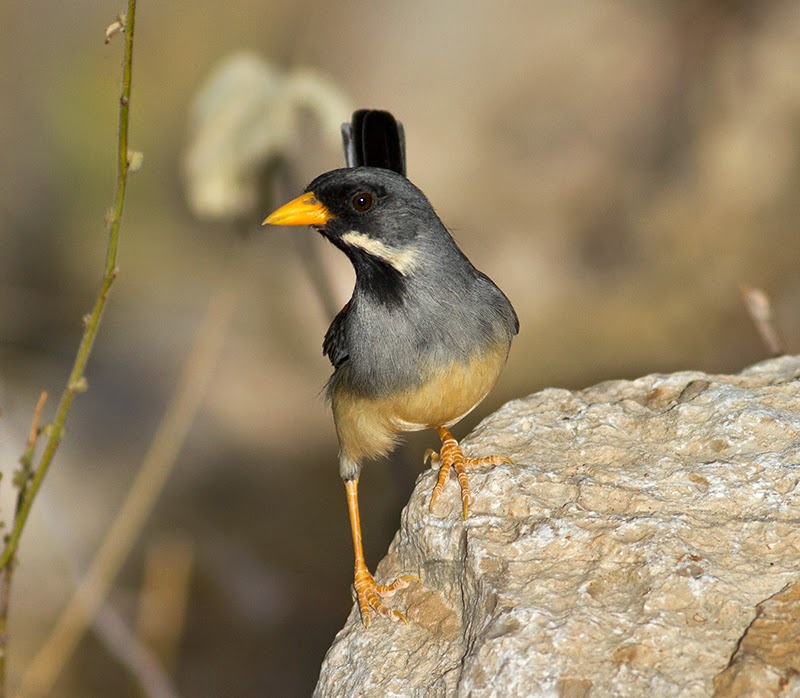This was to be another day of extremes; we started the day at "Black Mud Pass", which sounds much more interesting in Spanish (Abra Barra Negra), an area of remnant forest and grassland right on the treeline. In other chilly, windy and wet; at least it was for us on our visit. However, this pass, with its location on the lip of the Marañon Valley, allowed us to drop right down into the bottom of the canyon by the afternoon, where we needed to strip layers off, as we ended by birding in arid, cactus strewn slopes, with the sun beating down on us with considerable strength. Thus, from the start of the day to the end we crossed from one side to the other of this impressive valley, which also offered up some of the best scenery moments of this fascinating tour.
Our visit to Abra Barra Negra was haunted by strong winds, and cool temperatures, which gave us our most challenging birding of the trip. We had been largely trouble free with the weather on this trip until this point, but the morning was far from that. In spite of this, we forced out some early lifers: Coppery Metaltail, another endemic hummingbird for the trip, and a vocally distinct "form" of Rufous Antpitta that is likely to be recognised as a full species in its own right in time. Other high Andean birds sprinkled the farm fields up there, like Mountain Carara and Andean Lapwing.
I had dearly hoped to "grip-back" a Russet-mantled Softtail, which I had missed while I was gorging on Pale-billed Antpitta a few days before. I had reasoned at the time that I got the better of the deal, I would prefer to have got, than missed, the antpitta. However, like any greedy birder worth his salt, I was also keen to settle scores with that bird, but try as I might I could not find it. I tried standing outside the bamboo that they love, I tried standing inside the bamboo that they love, all to no avail. Much as I wanted the bird, the bird did not want me! Still, we saw some great stuff, including my fourth new owl of the trip, and the 11th seen on it for me! A Yungas Pygmy-Owl just sat there and let us stare at it, which I did, at length! Other finds, while fighting the wind and rain, were Andean Flicker, a woodpecker that seems, at times, to care little for trees at all; Drab Hemispingus, White-chinned Thistletail (of the peruviana form, which may be split), and Mountain Cacique. After failing to find a constantly calling Neblina Tapaculo in blustery conditions, which one of us saw briefly, we finally decided to call it a day and head down to less balmy conditions.
On our descent of the valley side we picked up Rufous-capped Antshrike and Baron's Spinetail, and took in some of the most impressive scenes of the trip, before we reached the hot and sweaty area of Balsas at the bottom of this impressive canyon. The base of the canyon was key to our hopes of finding another endemic, Peruvian Pigeon. A few flight views were had, before we walked along the road and found a tree full of them; find the fruit, find the pigeon! This species is listed for southern Ecuador, although there are many who now think that it may not occur there, and the sightings may have been mis-ids, thus designating this as a declining and scarce Peruvian endemic.
We were being baked near the valley bottom (in shocking contrast to our morning's feelings), when we located another major target, which behaved as if for our specific viewing pleasure: Buff-bridled Inca-Finch, arguably the best looking of the five Inca-Finches. This distinctive group of finches are all endemic to Peru, and are therefore highly sought after by people like me. I was keen on getting my first Inca-Finch on this trip, and knew I had a shot at four. The Little Inca-Finch seen on our second day was my first, but underwhelmed me, as it stayed distant, and did not allow me to snap a shot of it. Thus, this bird felt like my first true Inca-Finch, and it lived up to every bit of the hype, providing some of the best photos of the tour...
Next day we had a date with a parrotlet, and a long journey to the city of Cajamarca to undertake...

































No comments:
Post a Comment